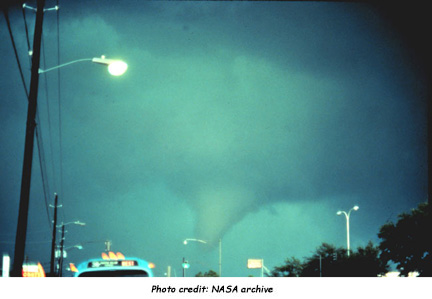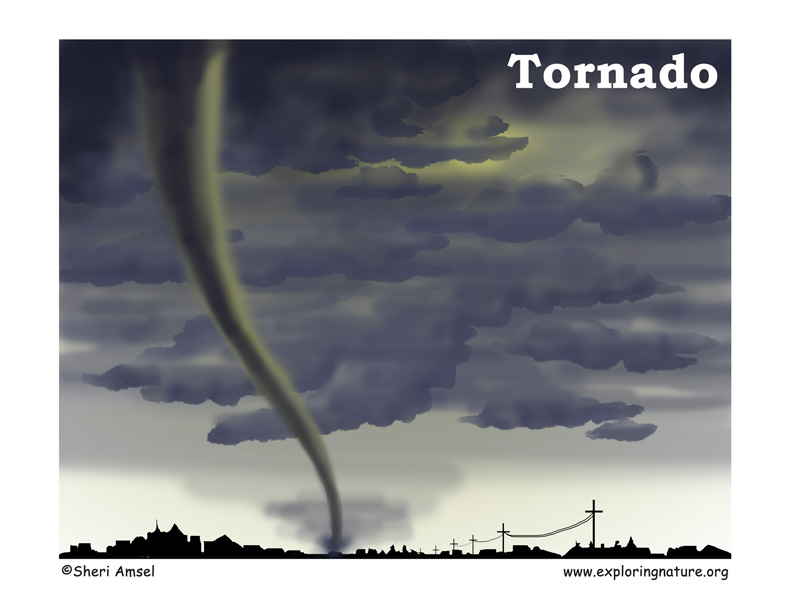

A tornado, also called a twister or cyclone, is a spinning, funnel-shaped cloud with huge power that moves along the ground grabbing, blowing and mixing everything in its path, like a big blender. Tornadoes usually spin counterclockwise around a center of low pressure. They vary in size from between just a few feet wide to a mile wide. Most are between 300 feet (100m) wide and 2,000 feet wide. Their wind power varies as well, but some develop winds that reach more than 300 miles per hour. This kind of wind force can tear the roof off a house, flip a car or crush a mobile home and cost towns millions of dollars in damage. Many lives can also be lost when a tornado travels through a community.
The United States has more tornadoes every year than anywhere else in the world. In recent years, there have been about 1,000 tornadoes per year, each doing damage to communities through which they pass. Most tornadoes form in the Central Plains, where springtime warm, humid air sits under cooler dry air. This is an unstable atmosphere, where strong wind shear can form powerful thunderstorms that spin off tornados. Though any state can have a tornado, the Central Plains states have them every year, so have been nicknamed – tornado alley.
Tornadoes begin to form in a thundercloud and stretch down to the ground, swirling up dust. This early formation of the tornado is called the dust-whirl stage. As the tornado grows stronger it enters the organizing stage. Then its gets wider, taller and stronger and enters its mature stage. This is the most dangerous stage, where tornadoes do the most damage on the ground. Soon a tornado will begin to lose power and enter the shrinking stage. Here is begins to tilt and become thinner on the ground. Finally it enters the decay stage where is begins to stretch and wiggle like a rope. Most tornadoes do not reach the mature stage, but break down and melt away instead. Though most last only a few minutes, they can do serious damage in their short lives. One powerful thunderstorm can create many tornadoes. This is called a tornado outbreak.
Tornadoes are born from thunderstorms. A single supercell thunderstorm can spin off several tornadoes. The most powerful tornadoes form in April when the wind shear is strongest, but more of them form in May – about 6 a day on average. They usually happen late in the afternoon when the atmosphere is most unstable from the sun heating the Earth’s surface.
Tornadoes are so dangerous because they produce winds that are strong enough to crush houses, pick up huge objects like cars, houses, trees and even people and carry them miles away before dropping them. They can hurl objects as if they are shot out of a cannon.
There have been many destructive and terrible tornadoes in U.S. history. There is nothing we can do to stops them. The only thing people can do is go to a safe place to hide until the storm passes. People in tornado alley often have storm cellars or places in their community to go to in case of an oncoming tornado. The trick is, they have to get there in time. Tornadoes can travel quickly and the people may only have minutes to get to safety. The National Weather Service tracks severe thunderstorms and sends out warnings about the possible path of a tornado. This gives people a chance to get to safety in case the twister comes right through their town. Many towns in this tornado alley have town sirens to alert the people not watching TV or listening to radio. Lives have been saved when people take these warnings seriously.
A historic tornado day happened in on April 11, 1965. It started with a powerful thunderstorm that spread through many states and spinning off many tornados. By the end of the day 250 people had lost their lives and 1,500 were injured. The high winds had knocked down so many power lines that the U. S. Weather Bureau (before it became the National Weather Service) could not get warnings to the towns where the tornadoes were headed. This tragedy started the development of the tornado warning system that would warn people of an oncoming storm even if the electricity has been cut off.
Tornadoes are a fact of life for those who live in tornado alley. No matter how advanced our technology becomes for tracking tornados, all we can do is warm people and even then people are still killed. We just cannot stop tornadoes.
On May 4th 2007, an intense thunderstorm that lasted for more than 6 hours spun off 22 tornadoes. The National Weather Service watched the storm and send off a warning to Greensburg, Kansas, a town of 1,500 people that was in the tornado’s path. It was a very powerful category EF-5 tornado (the most powerful tornadoes on record) with winds measuring at 250 mph. The tornado leveled the town, killing 11 people and injuring 60 more. If they had not had the warning though, many more people would have lost their lives. Tornado warnings don’t stop tornadoes but they give people the best chance they have to ride out the storm somewhere safe.
When you research information you must cite the reference. Citing for websites is different from citing from books, magazines and periodicals. The style of citing shown here is from the MLA Style Citations (Modern Language Association).
When citing a WEBSITE the general format is as follows.
Author Last Name, First Name(s). "Title: Subtitle of Part of Web Page, if appropriate." Title: Subtitle: Section of Page if appropriate. Sponsoring/Publishing Agency, If Given. Additional significant descriptive information. Date of Electronic Publication or other Date, such as Last Updated. Day Month Year of access < URL >.
Amsel, Sheri. "Storms - Tornadoes" Exploring Nature Educational Resource ©2005-2024. December 13, 2024
< http://www.exploringnature.org/db/view/1892 >

